Painting the interior of your home can be a daunting task, particularly if you’re tackling a number of rooms at once. Like most projects, you want to complete this painting as quick and efficiently as possible, but cutting some corners can create more work in the long run. From start to finish, taking a step back and to make sure you’ve avoided some of the most common mistakes will make your project of residential painting in Denver a success.
Ignoring things like holes, cracks, or other imperfections can have an impact on your finished look. Even minor imperfections should be patched or repaired, as this can lead to uneven application of your paint – which can leave an unprofessional look. Repairing or patching these imperfections generally won’t take that long, and can greatly improve the overall look of the completed paint job. You’ll also feel better about the surface getting painted, knowing it will result in a smooth and even finish.
Along the lines of the first time, it’s important to prepare the surface you’re painting. Even after you’ve patched and repaired the imperfections, surface prep is a crucial step. Clean and prepare the surfaces so that they’re smooth and free of dirt or other grime. Failing to do this can leave the surfaces inconsistent, which results in poor paint adhesion, which impacts the overall life and durability of the project. If possible, the use of a coat of primer can also make application much easier.
If you’re working in a space where some things need painting and others don’t, painter’s tape can be a very useful tool. Painter’s tape helps you achieve cleaner lines and help you avoid accidental splatter onto adjacent surfaces. It’s also important to note that not all painter’s tape is created equal. Getting the proper painter’s tape will keep paint from bleeding through, and it will also be just as easy to remove as it was to apply.
Light fixtures, outlet covers, and light switch plates can often be forgotten about once the painting process starts. Be sure to remove those covers and cover light fixtures before painting. This delivers a more finished look when the project is wrapped up, and it will protect those items from getting unsightly splatters on them. In rooms with appliances, try and pull them out of the way before painting to protect them, as well.
Paint is generally for walls, and even if you absolutely love the color, you probably don’t want it splattered on your floor or furniture. Be sure to cover your floors and furniture with plastic sheets or items like drop cloths. Accidents don’t always happen, but if they do, these precautions will protect against spills. Taking a few moments to cover everything will also give you the peace of mind in knowing they’ll be protected. In the event of a spill or splatter, these coverings will also provide for much easier cleanup.
Selecting a paint color without first testing it on a smaller section of the wall is an important part of the process. Try a number of different colors in patches on the wall to see how they respond to natural and ambient light. A certain color may look different online or under the paint store’s fluorescent lights than it will in your home. You’re going to be painting over that wall anyway, so perform the due diligence making sure the color is perfect for the space.
Investing in high-quality paint is one of the most important things you can do for your project. The quality of paint can make a massive difference in the final result, as higher-quality paint provides better coverage and durability. Going with the cheap option can result in applying more coats, and will likely have to be repainted sooner – which eliminates all of the benefits of saving money up front. Using high-quality paint from the start is a better option that will prevent headaches later.
Different room can require different paint finishes, depending on the amount of natural light and other factors. Semi-gloss finishes are good for areas with high humidity – like bathrooms and kitchens – providing a bit of shine while still remaining easy to clean. Satin or matte finishes have less sheen, and are often preferred for areas bathed in natural light since they aren’t too reflective.
Depending on the colors you’ll be painting with, you might need more than one coat to get the color and coverage you’re looking for. Applying multiple coats will ensure even coverage, and get rid of the patchy looks that can come along with particular colors on certain surfaces. Applying primer can also help with this, and applying multiple coats is more time consuming, but the end result will be worth it to get a complete, even look to the space.
Proper ventilation is essential, as many types of paints come along with strong fumes. Make sure the area you’ll be working in is properly ventilated by opening doors or windows. If the space has limited options for natural ventilation, be sure to use fans to direct the fumes out of the space. Having fresh air in your work area will allow you to work longer in the space, which will cut down the project time and keep you away from any harmful fumes.
Being thorough and taking your time with the project is essential. Rushing through the painting process can led to plenty of mistakes – including uneven coverage and a shoddy appearance. Painting interiors takes time, so you have to embrace the process and understand the importance of making sure everything is evenly covered. Rushing through a painting project can actually add time to it, as you’ll likely have to go back and even out the coverage of paint over mistakes.
Once the project is finished and you’ve applied all of your coats, it’s important to take care of the tools that helped you get there. Properly clean your brushes, rollers, and other tools, so that they’ll be in good shape to produce optimal results on future projects. These should also be stored properly, and tools that have run their course should be disposed of properly, as well.
There are a lot of things many people miss when painting their interior. Leave it to the experts and reach the best residential painting Denver company today.
Making your commercial space look unique and individual to your business is an important aspect of building your image. While you want this space to look updated and professional, you also want it to be inviting and modern. With many businesses running on tight budgets the way it is, finding ways to fit these upgrades or enhancements into your budget can be difficult.
There are a number of different ways to update – or even overhaul – a space without emptying out your business account. It’s just a matter of getting creative with the space you have, and performing the updates that will give you the most bang for your buck. From a few simple coats of paint to performing cosmetic updates to the other elements in your space, you can have your commercial area looking brand new in no time.
A crucial step in improving any space is to formulate a plan before getting started. When looking to enhance a commercial space, this starts with identifying the most important areas that need improvement, and prioritizing those spaces based on how they’ll impact the clients that will be coming through your office every day. Once you know the overall spaces, you’ll be able to get a better view at what the changes will cost, and a timeline for getting the changes made. Don’t be afraid to get help from a professional. Many people can get insight on cost saving methods from experts in commercial painting in Denver that can really make a difference.
By creating a detailed plan that highlights the changes you want to make, it can give you a jump on all of the costs that you might incur through the process. Knowing which spaces will take priority in your commercial space will better allow you to allocate resources – particularly if you don’t have the budget to knock out all of the changes in one fell swoop. Prioritizing the changes will also offer insight into where costs might be able to be trimmed to get all of your changes made.
Before diving into the deep end as far as expenses go, take care of the easy stuff first. Many people are surprised by how a fresh coat of paint can dramatically transform a commercial space. Commercial painters can give insight into what colors to use to make a particular area appear more spacious. You also don’t have to paint an entire room, as an accent wall can offer an interesting visual piece to any space. Along with painting, another thing that can be done quickly and easily is replacement or upgrading of light fixtures. Getting the right energy-efficient bulbs can help brighten a space, deliver a more inviting atmosphere, and save some money on utility bills.
Another way to freshen up your space is to update your décor. This doesn’t have to be expensive, either. Many people create their own artwork or decorative items to give the space an individual look that’s specifically unique to you. There are also a number of places to get affordable furniture and décor, from auctions and other online marketplaces to thrift stores. Use a little creativity to find pieces that give your space character.
Sometimes clearing out unnecessary clutter can make a world of difference. By getting rid of some of the excess items in a space, it can make the area look more spacious, as well as more organized. Cut the visual distractions down to a minimum, and it can really change the look of a space. That doesn’t mean the place has to be completely bare. Decluttering the space can make it look roomy, and adding plants can give a more pleasing environment. You also might be able to repurpose some of the current things you already have. Giving old furniture a fresh look through a coat of paint or other upgrades can also do wonders.
While you’re looking over the space, check out the window treatments. Things like curtains and blinds are easy to upgrade, and can significantly enhance the space’s atmosphere. Touch ups like these can go a long way in making a place look new and vibrant. Window treatments are an inexpensive option to upgrade, and can completely change the overall look to a space.
While trying to get the most out of your area, it’s important to make sure it fits in with your surroundings. Having your commercial space fit in with other design elements from the surrounding area can go a long way in making it memorable. Whether it’s utilizing a palette of paint colors that matches the surrounding area, or utilizing some of the common themes in your signage, this can really hit close to home with the people visiting your space.
One way to potentially get some wonderful artwork on the walls of your commercial space is to collaborate with local artists. Set up a partnership with them to display some of their work in your space. This will give your space a unique look with a local vibe that’s individual to the area where you work. This also supports the local art community, putting their images out in front of the public. It might also be an inexpensive way to get some sharp artwork in your office space while creating a partnership that could get the word out about your business, as well.
There are a number of ways to make your space seem new again without breaking the bank. All workspaces need to look modern, and they also need an air of professionalism without sacrificing your individuality. You want your space to be comfortable to work in, but you also want it to be memorable for your visitors. For more information on how to make your space a bit more enhanced while working within a budget, reach out to the experts at Colorado Painting today.
When you are choosing a commercial painter, you want to pick the one that satisfies your needs and budget. However, it’s a sad truth that many commercial painting contractors out there are not very trustworthy and professional.
While some commercial painting contractors will pass themselves off as certified, licensed, and insured professionals, this isn’t always accurate. Sometimes, when you hire a commercial painting specialist, you end up with disappointing results. To avoid this kind of problem, you can make sure that you’ve partnered with a dependable Denver commercial painting contractor.
It’s critical to make sure you have the whole picture when trusting someone to accurately paint your commercial property. If not, you can be subject to liabilities and other problems. True commercial painting professionals will safeguard their clients and their team.
There are a couple of vital points to review before choosing a commercial painting contractor. To make sure that you are working with an authentic commercial painting contractor, check out the tips below.
The first thing to do when choosing a commercial painting contractor is to always look at past painting jobs by the commercial painter before agreeing to the contract. A customer online review could also work to know what a previous client said about the commercial painter you’re thinking of hiring. Additionally, you could look at the current completed jobs to see the work done by the contractor. Select the one whose style and work ethic match what you want in a commercial painting professional.
Typically, a good commercial paint job should last up to 10 years. Pick a Denver commercial painter who uses the latest tools and ask about the paints they use. After all, you don’t want them using subpar products that may be unsafe for people on your commercial property.
This is always one of the most crucial factors to take into account. Commercial painting contractors must have the right skills necessary for the project. The best commercial painter will have a vast portfolio of various properties showcasing their expertise.
Painting is a hazardous job, and the contractor must safeguard you from any liability by possessing the right insurance. The contractor must also be bonded to ensure that if they don’t finish the job, you won’t lose your money.
Colorado Painting manages all sizes and types of commercial painting projects. Our commercial painters take excellent care of our clients, which is how we’ve become the favorite painters of numerous Denver businesses.
Don’t settle for less experience and uninsuredness when it comes to commercial painters in Denver. We have years of expertise delivering exceptional client service and top-quality work with positive feedback to back it up. The job isn’t finished until you’re totally satisfied with our work.
We strive to be the preferred company for commercial painting in Denver by delivering exceptional service to our customers. Contact us today to bring new life and color to your commercial property.
Taking on a major paint project can be a pretty arduous task. You have to plan out how much paint you need, do all the prep work, and factor in drying time and multiple coats. However, one thing that a lot of people seem to overlook is the type of paint they use. Depending on the surface you’re painting on and a few other factors, you’ll want to decide between enamel or latex paint. Down below, we’ll compare and contrast enamel vs latex paint, list the pros and cons of each, and discuss where you might want to use each paint type.

The main difference between enamel paint and latex paint is the difference in paint bases.
Enamel paint is oil-based, whereas latex paint is water-based.
Enamel paints, also sometimes referred to as hard-surface paints, dry slow but hard, making them perfect for hard surfaces. Latex or water-based paints are fast-drying paints that are more malleable, making them the appropriate paint for projects where the surface may expand or in locations where movement and flexibility are required.
Now that you know a bit more about the chemical difference between enamel and latex paint, we’ll now take you through a few different factors you’ll want to consider when choosing between enamel and latex paint.
Deciding on the finish that you want for your project will help to narrow down your choice of paint.
Eggshell and matte, or flat finishes are only available with latex paints. This latex finish is considered to be the more modern and sophisticated of the two paint types. Latex paint’s finish is easy to clean and is durable enough to withstand all high traffic areas in your home. Satin finish is available as latex paint but can also come in enamel paint.
Enamel dries with a hard glass-like finish that is easy to clean and hard to stain. Enamel paint is available in satin, semi-gloss, or high-gloss. Oil-based/enamel paints are commonly used for trim, cabinets, and other possible high-impact areas due to the high durability of enamel paint’s finish.
The flat or eggshell look of latex paint is a modern look that has become popular for use on interior walls and ceilings in homes.
Flexible yet durable, latex paint is also easy to clean and water-resistant, making it ideal for most interior projects. While durable and waterproof, latex paint remains slightly flexible even when completely dry, making it ill-suited for the exterior climate.
Conversely, the hard glossy finish of enamel paint can look harsh and dated over large areas indoors but is well suited for the outdoor sunshine and elements. Although oil-based or enamel paint tends to fade and yellow over time, exterior oil-based paints in neutral or earth tone colors such as beige, tan, or taupe will be less likely to break down and fade than other oil-based paint colors.
Fumes from any paint in significant amounts can cause lightheadedness, headaches, irritation to the eyes, or trouble breathing.
Latex paint has a milder odor than enamel paint, making it a better choice for walls and bigger projects. Being higher in fumes, oil-based enamel should be reserved for smaller projects or used outdoors when possible.
With either type of paint, if you must be indoors, work in a well-ventilated room or area and open doors or windows to circulate airflow if possible.
Paint additives, extenders, or conditioners can improve your painted project’s overall final look by slightly thinning the paint, elongating the drying time, and allowing the paint to level itself and lay flat for a smooth finish.
Floetrol, shown below, while not the only brand available, is the most popular paint additive for latex paints. Penetrol, also shown below but not the only brand available, is the most popular paint additive for oil-based paints.
Thick even coats of paint can create a smooth brush mark-free finish when the paint is left to level and dry properly.
Latex paint dries faster, so paint must be laid quickly and left to level. Enamel paint takes longer to dry but has a better finish due to the oil-based paint actually absorbing the surface being painted. A longer drying time allows for enamel paint to be manipulated for longer to ensure the perfect thick even coat.
Cleanup of latex paints typically requires only water and a rag. As latex paints are water-based, clean-up is fairly easy.
Enamel paints require paint thinner, such as the one pictured below, for cleaning brushes and surfaces that paint has spilled on.
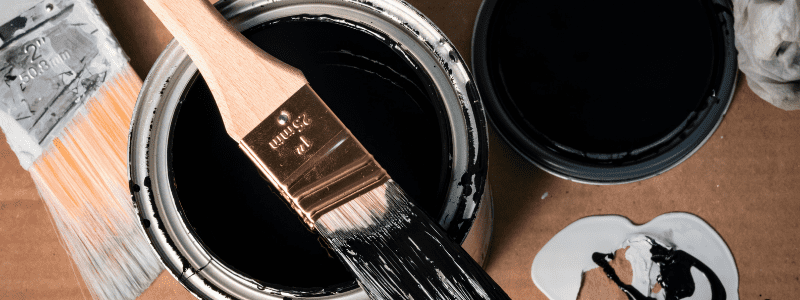
Oil-based enamel paint’s longer drying time may seem like a disadvantage, but the longer drying time gives you more time to work with the paint for a perfectly smooth coat. Enamel paint also goes onto surfaces smoother and with better coverage coat for coat compared to latex paint.
The smooth thick coats of enamel paint left to level and dry will result in the desired flawless durable finish.
Ease of cleaning is another advantage of enamel paint. A good rule of thumb is the shinier the paint finish, the easier it will be to clean. Enamel paint is also waterproof, making it perfectly suitable for any outdoor condition.
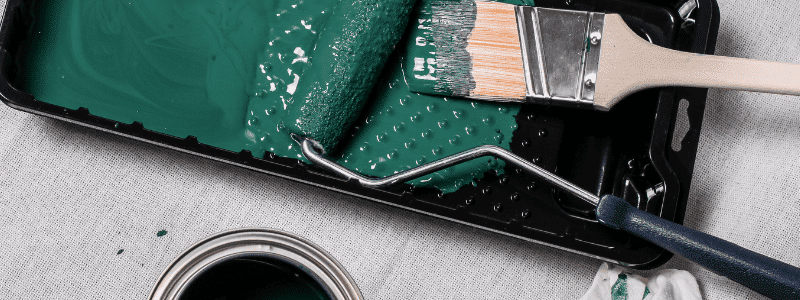
If you want to paint on unprimed drywall or stonewall or brick wall, you should opt for latex paint and a suitable latex paint sprayer.
It also works well on surfaces that have already been painted with other latex or oil-based paints. In addition, it is a more budget-friendly option that works well on large interior walls.
If you live in the Denver, Colorado area and are looking for a commercial or residential paint job, you should look no further than Colorado Painting.
We have been Denver’s best painting company for 38 years, with a proven track record of excellence, no matter what your project calls for. We’ve done it all – interior, exterior, deck staining, and foundation painting, so you can be sure we can handle your job.
Contact us today to discuss your painting needs and get a free estimate.
Environmentally friendly paints are defined as having no detrimental effect on the environment, nor on society.
At Colorado Commercial & Residential Painting, we are inspired to help preserve the quality of the air we breathe and value the use of environmentally friendly paint that minimizes air quality impact without sacrificing performance.
Although paint is available in a rainbow of colors, not all paints are "green".
It's typically a simple thing to spot the difference between environmentally friendly paint and conventional paint. All you need to do is just pop open the lid and take a whiff.
The familiar fresh paint odor of a conventional latex or especially a solvent-borne paint consists of a variety of greenhouse gases and other environmentally harmful chemicals that are released to the atmosphere as the paint is applied and in the drying stages.
Eco-friendly paints, however, emit little or no environmentally unsafe materials into the air (we call these VOCs, which we talk about more below).
Many environmentally friendly paints contain ingredients like natural dyes, water, milk, casein, essential oils, plant oils, and resins. Additional ingredients are derived from natural minerals such as clay, chalk and talcum, milk casein, natural latex, bees’ wax, earth and mineral dyes. The oil-based natural paints usually have a pleasant fragrance of citrus or essential oils, while the water-based natural paints give off almost no odor at all.
These paints are proven to be the safest for your health and for our environment.
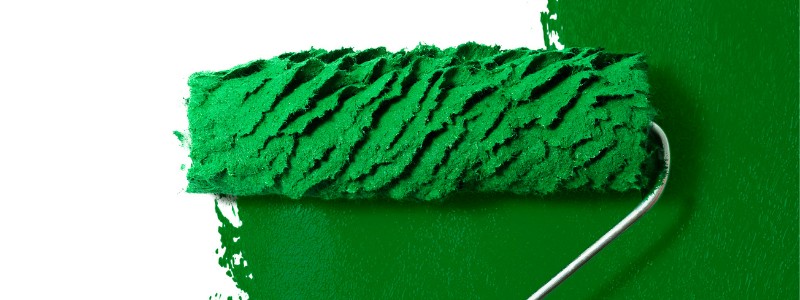
The air you breathe indoors is more than three times as polluted as the air outdoors. A major source of indoor air pollution can be interior paint.
The reason is that most of these paints may contain harmful compounds, toxic substances, and chemicals – VOCs.
The paint production process can also very be energy-intensive.
VOCs are volatile organic compounds.
These include hydrogen and carbon. They evaporate easily into the air we breathe and can cause serious health concerns when inhaled.
The “green certified” paint that we can apply for your special project has no or low volatile organic compounds that are also harmful to our precious ozone layer.
These environmentally preferable coatings have been thoroughly tested according to science-based procedures and are proven to work as well or better than others in their class.
Well, just about everyone and everything benefits from environmentally friendly paint.
As we just mentioned, eco-friendly paints contain little-to-no VOCs. Thus, they are safer for our air and everything that breathes it.
They don't impact the ozone layer. Using eco-friendly paints lightens your carbon footprint.
Environmentally friendly paints contain natural ingredients like clay, milk proteins called casein, citrus, lime, and balsam.
Eco-friendly paints emit little-to-no smell. Moreover, the odor dissipates in under a few hours.
Besides being eco-friendly, these products are also effective in reducing mold, condensation, and mildew.
Eco-friendly paints meet the EPA and GREENGUARD Environmental Institute standards for environmentally friendly paints.

Although environmentally friendly paint is mostly beneficial, there might be some reasons people don't want to use it.
We carry a wide variety of environmentally friendly paints from brands like Sherwin Williams, Benjamin Moore, and KILZ. If you'd like to use this type of paint on the interior or exterior of your home or business, we'll make our best recommendations.
Contact us today for a free estimate.
This question is one that many professional painters hear all the time: how long does interior paint last on the wall? Ultimately, however, this question is nearly impossible to answer. A general rule of thumb is that a well-done interior paint job will last between 5-10 years, and potentially even longer. However, your paint’s longevity is based on a bunch of different factors. So, how long does interior paint last on the wall? Well, that depends.
In this article, we’ll take you through some of these factors (such as paint quality and room purpose) in an attempt to help you determine how long your interior paint job will last.

Since it’s hard to put a specific figure on how long interior paint lasts, it’s also pretty difficult to figure out when it’s time to repaint the inside of your home or office. In order to properly assess when it’s time to repaint, you need to keep track of when, how, by whom, and with what your last paint job was done. For example, a well-done paint job done by a trusted painting company such as Colorado Painting will generally last longer than a paint job you paid your teenage son and his friends to do.
You can combine these objective facts with your intuition and other factors. If the room in question is a playroom or somewhere that hosts a lot of activity, chances are the walls will get scuffed and chipped much more frequently than a home office. Additionally, some families or business owners may be more tolerant of peeling, fading, or scuffed paint than others- so choosing when to repaint is also a personal preference.
The type of paint used in your paint job will also help you answer how long does interior paint last on the wall? Really, there’s no reason why a coat of quality paint done by a professional painter cannot last upwards of a decade.
There’s a reason why some types of paint are more expensive than others – it’s because they’re expected to last longer and look better on your walls. Going with high-quality paint as opposed to the cheapest option at your local hardware store is a good way to ensure that your interior paint job lasts longer.
There are also different types of paints that you can use.
Traditionally, interior paints fall into two broad buckets: oil-based or water-based.
We’ve compiled a list of a few characteristics and advantages of choosing each type of paint down below:

The finish you choose for your interior paint job also impacts its longevity. For paint finish, there’s a sliding scale that ranges from non-reflective and almost paper-like to extremely shiny. The glossiness you choose has a direct impact on how easy the paint is to clean, which in turn can boost longevity.
Flat: Flat is the least reflective type of paint finish. Since it’s cozy, tough to clean, and matte-like, it’s a great choice for low-traffic areas such as formal living rooms.
Satin: Satin is still relatively non-reflective and matte-like, but contains a hint of gloss. It’s one of the interior paint finishes.
Eggshell: Eggshell finishes tend to have a fairly even glossy finish. This level of glossiness is often extremely easy to clean with a damp cloth, making it a popular choice for anybody who is concerned with longevity.
Semi-Gloss: Semi-gloss is an even more reflective finish than eggshell, and tends to be much more durable. This is a popular finish for high-traffic areas that require significant paint durability, such as a kitchen or bathroom.
High Gloss: High gloss, often also called gloss, is the shiniest finish available. Generally, this finish is only used for wood trim and molding since it’s both the most decorative and the easiest to clean.
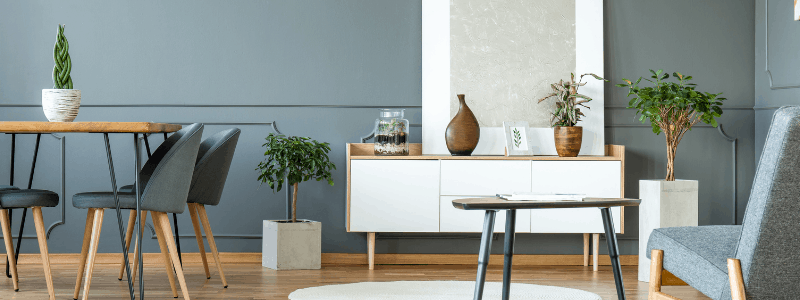
When asking how long interior paint lasts on the wall, there are more factors to consider than just paint type and finish. Down below are a few more factors that will influence your paint’s longevity:
One of the best ways to ensure a quality, long-lasting paint job is to use a trusted professional.
If you are in the Denver, Colorado area, there is simply no better company to use than Colorado Painting. We’ve been Denver’s best painting contractors for almost 40 years, with both residential as well as commercial interior paint jobs.
We pride ourselves on delivering high-quality work, being locally owned and operated, having a great reputation, and having a high level of experience.
We also include an automatic service guarantee for every project we do.
Please feel free to reach out to get a free estimate today!
Now might be perhaps the best time in recent history to repaint an office. People have been working from home for the past year and a half, but offices are starting to reopen countrywide for employees. These openings are varying state by state and company by company, but with many employees continuing to work from home, now is a perfect time to repaint an office without disrupting any work. No matter what you call your "office," here are some commercial office paint color ideas.
When analyzing and looking at different commercial office paint color ideas, it is important to consider the theory of office color psychology.
Office color psychology is the basic theory that different paint colors can help spur creativity, productivity, or focus. There have been many studies that show that color psychology helps improve not only employee productivity and satisfaction, but also positively influences how clients and visitors perceive your business.
Office color psychology draws from the fact that people perceive different colors to have different meanings: for example, in the USA, people often perceive red as bold and exciting and perceive blue as calming.
Color meaning can either be culturally specific or biologically innate, and colors generally influence behavior automatically. Office color psychology takes advantage of these preconceptions of color to create a workspace that is conducive to employee productivity and performance.
Now, let's take a look at which colors are best for specific purposes in the office, and hopefully, they help spark some ideas for your office:
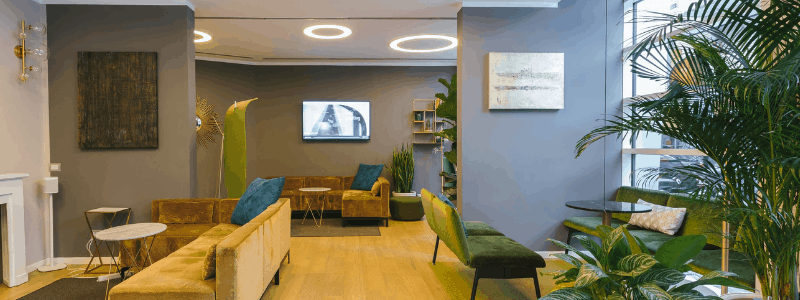
There are a variety of colors that work well to spur focus and productivity depending on the industry, job duties, and desired level of focus.
Industries where employees need to be productive and perform repetitive tasks love the color of light blue. This color is soothing, encouraging clear thoughts and reducing mental strain.
Several scientific studies have found that red is a stimulating color, so it increases heart rate and boosts blood flow. If your job requires you to be mentally alert or physically active, red is a great choice. Don't use red in excess, however, as it may promote aggression or competitiveness.
Since it boosts attention levels, yellow is often said to be the learning color. Including yellow in areas focused on learning can help employees absorb and retain information better.
As a combination of intense red and attentive yellow, orange is a great color to stimulate both the mind and the body. Orange is best used as an accent color to boost productivity, as too much orange can be distractive.
Green is a gentle and easy color, which is perfect for offices where people frequently work long hours. A great way to include "green" outside of paint is by having plants around the office. And there are certain colors that really help the green plants "pop" out around the office, like orange or yellow.
Traditionally, colors that work well to boost creativity are ones that are energizing and exciting. If you're in an office where you are needing to be creative, here are some good commercial office paint color ideas for creativity:
Yellow is also a great color for creativity since most people associate it with the sun, and therefore warmth and light. Yellow can inspire excitement and innovation.
Adding touches of orange around the office can give it a vibrant and warm feel, which creates a sense of confidence and comfort while still being fun.

The best colors for comfort are traditionally lighter colors that can add spaciousness and an airy feeling to the office.
Blue is the first color that comes to people's minds when they think of calming colors. Sky blue in particular has a refreshing, calming, and soothing effect that is perfect if you often deal with agitated or nervous customers, such as if you are a dentist.
Pink has similar warmth and energy as red without having such an intensity. Pink is so effective at relaxing people that many prisons use it to calm violent inmates! It is a warm, feminine color that radiates calmness and hope.
Green is a restful and reassuring color that is often associated with well-being and balance. Green color in an office can help to “trick” a brain into thinking it is outside, which is proven to help relax anxious and nervous individuals.
Light and airy, pastel colors are just colors that contain a lot of white. Since they are less saturated, pastels are often perceived as soft and soothing, which is perfect for inducing calmness.
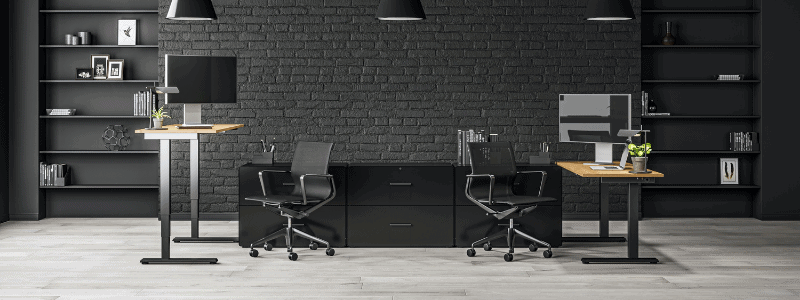
Dark, intense colors traditionally convey power best.
Black is often associated with power, authority, and control. If used properly, it can make your office look both mysterious and elegant. Too much black, however, can come across as sinister.
Pairing rich brown wood furniture with a brown backdrop is a tried and true method to showcase power and strength. Although it has the same dark properties as black, brown also has a warmer, earthier feel that balances out the mystery and intensity associated with black.
To provoke happiness, either bright or soothing colors should be used.
Yellow, in addition to its other properties, is also a bright fun color that will excite people. Many people associate it with the sun, and since sunlight promotes the release of pleasure and relaxation hormones, yellow has a similar effect.
Orange has been proven to increase collaboration and spur conversation. Including orange in break areas can help employees spark up conversations that fill our need for social inclusion while simultaneously providing us with a full mental detachment from work.
Deeper pink is a great color to evoke the energy and happiness of red without its intensity. It is best used as an accent color, as too much pink can feel draining and claustrophobic.
As you can see, there are truly endless opportunities for different commercial office paint color ideas. The best color and color combination will depend on your individual needs, such as the industry you work in and whether this is a traditional office or home office. If you're looking to repaint to optimize productivity and happiness, you should look no further than Denver painting contractors.
We have decades of experience and will work with you to tailor your paint job to your specific needs. Contact us today!
At Colorado Commercial & Residential Painting, we know the ins and outs of commercial painting. We can help complete your next project with our team of high-quality painters that deliver nothing but the best. Whether it's a restaurant, office space, healthcare facility, strip mall, government building, retail, lobby, or other exterior or interior job, you can trust that it will be done right the first time. We are a Denver commercial painting company that believes that quality blended with excellent service is the foundation of success.
Our award-winning company has completed a wide array of commercial painting projects in the Denver area since 1983 and complete painting projects such as:
No matter where in Denver you're located, your business is our business.
As professional painters, we will make it our priority to make sure your commercial building reflects the quality of service or product you provide.
We are experts, we are locals, we are efficient, and we are dedicated to your complete satisfaction.
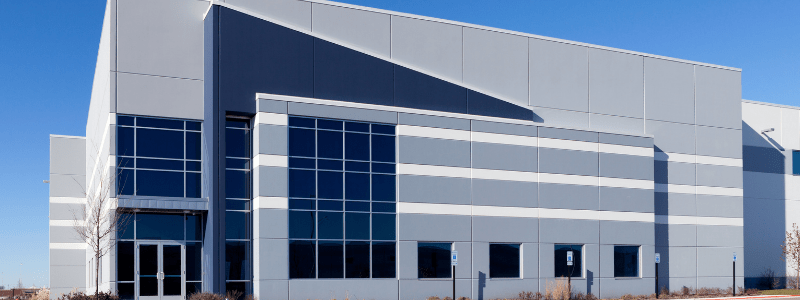
Some areas of Denver are more commercial than others, so when we say "Denver" we mean all surrounding areas, too.
Our Denver commercial painting services include places like:
If your business is anywhere close to Denver, you can expect our commercial painting experts to keep your building looking its absolute best – inside and out.

There are a lot of "painting companies" in the Denver area that don't necessarily focus on commercial painting projects until an opportunity comes up and they're in over their heads. We've seen it and most of the time, we've had to redo their work.
There are a few things you should keep in mind when you're looking for a Denver commercial painting company that any professional, legitimate painting company should be prepared and willing to share with you.
What type of liability coverage does the painting company carry? Do they cover all of their employees' Workers' Compensation Insurance? You can ask for their licensing and insurance information at any time. What kind of safety policies do they have in place, to comply with federal, state, and local regulations?
Do they have any past work examples they can show you? Have they done commercial buildings like yours in the past? What do those businesses have to say about their experience working with this painting company? Can they provide any images or further details?
Each painting company you talk to should establish a point of contact, from whom you receive all updates, at least every day of the project (if not more frequent). They should be available for all questions, concerns, or comments you may have at any point during the painting project.
What do Google, Facebook, and other online platforms say about this commercial painting company? When you type in "Denver commercial painting company" do they appear in the search results? Does their location? Do their reviews? This speaks volumes about their work.
What kinds of products do they carry? Do they have different options for you to choose from depending on your needs, budget, and code/regulations?
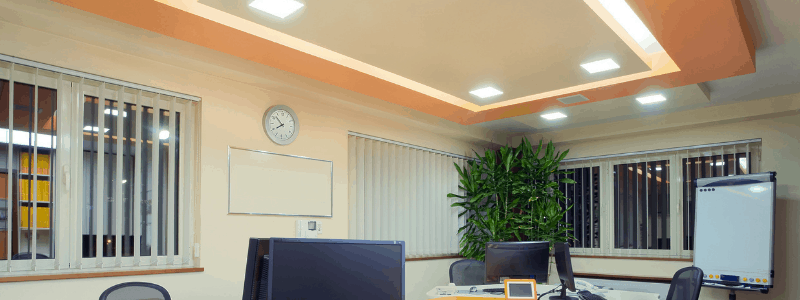
We hold ourselves to the highest of expectations, so we expect you to hold us to that, as well. Here's what you can expect from us, with any painting project – no matter the size.
Our bondable company carries comprehensive insurance including:
Our insurance protection is just one of our many ways of saying that we are fully committed to providing a clean and safe work site for all our employees, customers, and their clientele.
We pride ourselves on the wide variety of Denver commercial paint projects we've done around the Denver area. We've got quite the resume of different projects that you can look into. We're also happy to share further details on relevant projects upon meeting with you. Until then, you can also see some of our commercial projects in our blog.
No amount of communication is too much. After all, this is your building, you deserve to know what's going on at any given point. We'll make sure you know who you can talk to, when, and how, at all times. We're available to respond to any questions, concerns, or comments promptly.
We have over 100 Google Reviews, with a 5-star rating. You can also check out our long list of reviews here, which we update frequently.
We know all of our team members by name and stand by their work. With commercial paint projects, we typically have 30 professionals with solid experience, to get the job done right (the first time).
We have a variety of brands and different paints to match your needs.
In addition to performing interior commercial painting, we offer electrostatic painting and the application of specialty finishes, such as the application of Scuffmaster/Zolatone type products.
We also install a variety of wall covering products including:
The painting process includes:
Colorado Commercial & Residential Painting is also an EPA, lead-safe company that properly repairs lead remediation issues on commercial properties built prior to 1978.
When you choose Colorado Commercial & Residential Painting for your Commercial Building Complex, Office, Homeowner Association, or Multi-Family Painting needs, you can count on your project being completed properly, safely, on time, and within budget!
Call today for your FREE estimate at (303) 574-1740!
Whether its your home or a commercial property, there are a handful of elements to your painting job that you must consider before starting. One of the most important being the infamous color choice but you also need to consider the paint sheen you want especially in regards to the area you are looking to paint. The sheens range from flat, which has no shine but hides imperfections, all the way up to High-gloss, which is very shiny but the most durable.
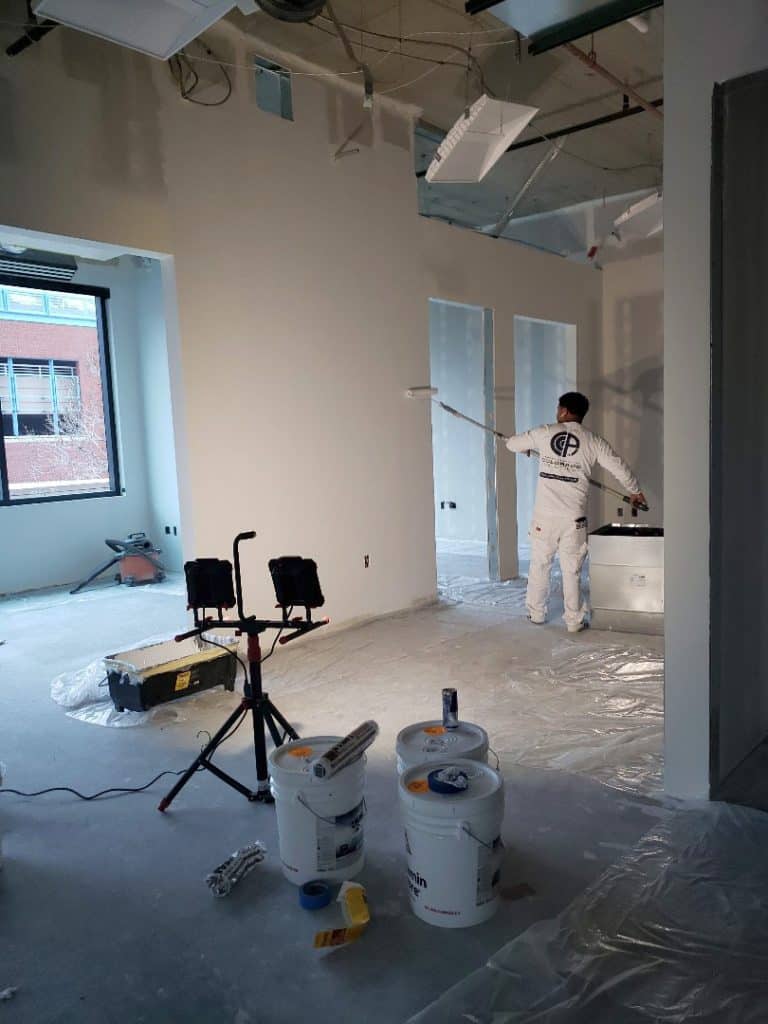
Depending on the paint brand you use, they may have more, less or hold slightly different names. However, most should be able to fall into one of these 5 categories.
When choosing a paint sheen, you want to consider several factors outside of just the finish and overall look it provides. Paint’s biggest purpose is to protect the material beneath and to be able to protect it, you need to understand the needs of the area in which you are painting.
Sherwin-Williams suggests using there paints in the following areas of your home:
High traffic areas are perfect for sheens that have a little more gloss in them. The higher the gloss, the more durable it will be! Satin is said to be one of the most versatile paint sheens. It is often used on the exterior and is popular on the interior of your home or commercial property because of it’s pearly finish and overall durability.
If your worry isn’t durability and you are more focused on helping hide imperfections, then flat or matte sheens are a great choice for you. They will help cover up surface flaws such as dents and scratches which could end up saving you some time and money if they are placed in areas that are not prone to scuffs and damage. Since there is no gloss in these finishes, they are harder to clean and may require touch ups.
Choosing the right paint sheen for your space is crucial in the success and longevity of your paint job. Seeking help from experienced, reliable, and professional painters like Colorado Commercial & Residential Painting will ensure you get a high-quality paint job that lasts.
Contact us today to get a free no-obligations estimate!
Lead was added to paint originally for several reasons. The metal additive not only helped to deepen the color but it also had increased dry time, better durability and was moisture resistance. Lead paint quickly became the go to product for residential homes and even children’s toys. It was used in millions of homes before it was banned for use in 1978.
High levels of lead in your body can be very dangerous especially for children under 6. For them, the lead can affect their brains and nervous systems which often cause behavior problems, reduced IQ and learning disabilities. Infants and children are the most susceptible to lead poisoning, but it is also harmful to adults even in small amounts.
Serious cases of lead poisoning could lead to anemia, impaired brain and nervous system functions, and even death.
A study from 2002 found that 38 million housing units had lead-based paint. It was added into both interior and exterior paint throughout the early to mid 1900s.
If you’re home was built before 1978 then there is a higher chance that lead paint was used on your property.
The most common way lead gets into our body is from dust. This could come from deteriorating paint that is peeling, chipping, chalking, cracking, damaged or damp. It could also stem from renovations and repairs you are completing on your home that includes disturbing the paint by sanding, cutting or demolition.
It can also be dangerous when found on surfaces that young children often chew and play by like:
If you want to take care of it yourself, you can use a at home lead test kit. These can be found at your local hardware store. When testing the paint make sure to test different areas of the house. Different colors means different batches of paint and you should double check all areas.
When using a licensed and certified EPA Lead Renovation contractor like Colorado Commercial & Residential Painting, testing the exterior on houses built before 1978 for lead paint is part of our everyday procedure. With decades of experience, we have the knowledge and experience to make sure testing and remediation is easy and stress-free for our customers.
If your home tests positive then you or your contractor should be following EPA lead-safe practices such as containing dust inside the work area, utilizing minimal dust methods and conducting careful and thorough cleaning. Colorado Commercial & Residential Painting is experienced with these methods and will provide you with a copy of the EPA Lead Safe Certified Guide to Renovate Right booklet for you to review prior to work beginning.
Give Colorado Commercial & Residential Painting a call for your free estimate today!